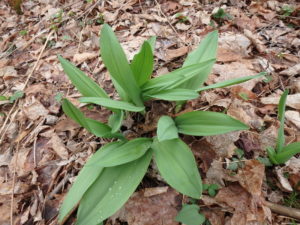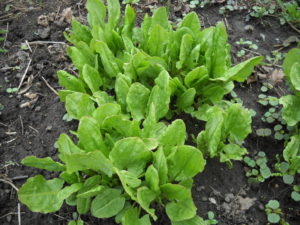A Taste of Spring!
I’m already eating a few of my own fresh vegetables: ramps, dandelion greens and sorrel are ready, and soon will come those perennial delicacies, asparagus and rhubarb.
It took me nearly 10 years, but I now have a patch of ramps that produces enough of these wild members of the onion family that I don’t have to go hiking to dig up the ramps I need. I sauté both the bulb and the leaves, and find them a great spring treat in eggs or a stir fry.
Ramps are often found in areas with moist soil and filtered sun and shade. They are slow-growing, but I have added 50 or so plants most years for 10 years and the older clumps are ready for harvesting.
Ramps often are found in patches of a million or more, but that does not mean you can be careless about harvesting them – a patch that sizes takes a lifetime or more to develop. Dig a few in one spot, move to another – and never take all from any one location. If I dig out 25 from one spot, I am sure to leave half a dozen in the ground.
If you want to start your own patch, first learn to identify the plant. They have leaves that are 6 to 12 inches long and 1 to 3 inches wide with a pointy end. There is a groove down the middle of the leaf, and the lower stem may have some maroon coloring. And the scent is distinct, similar to garlic and leeks. The bulbs are half an inch wide or so, and two inches long or less, depending when you pull them. There is an outer sheath over the bulb which you should slide off when you cut off the roots.
To grow your own, carefully observe where you find them in the wild. Look at the trees: often maples and beech, sometimes ash or poplar form the canopy. Wildflowers that grow along with ramps include spring beauty, Dutchman’s breeches and trout lily.
The soil for growing ramps should be rich and dark. If you want some near the house and kitchen, dig some up and try to match the environment where you find them in the wild. Be sure to ask the landowner if you want to take some from a neighbor. These are spring ephemerals, so the leaves will die and disappear before mid-summer.
I know that many gardeners think of dandelions as pests, and they can be. But they are also tasty if you dig some before they bloom; after blooming they tend to get bitter.
To harvest dandelions, bring a table knife with you to a patch of lawn or garden that has not been treated with chemicals – no herbicides, no chemical fertilizers, no pesticides. Slice the roots an inch beneath the soil surface and lift the dandelion carefully as you don’t want to sprinkle any soil onto the greens. The white portion just beneath the soil is delicious, but you can toss the brown-skinned tap root.
I wash the dandelions with the sprayer in my kitchen sink, and then leave the roots in a bowl of water to loosen any more soil. Then I return and rinse them after soaking. I like to steam them lightly, then serve with cider vinegar or a little butter. Although I eat them the same day I pick them, my late friend Rev Wightman used to freeze them and eat them throughout the year.
Sorrel is a great favorite of French cooks who make a soup with it. Although I grow it, I am not wild about it. It is a bright leafy green that comes back, year after year. It has a sharp lemony flavor, a bit like wood sorrel. My problem with it is that when you cook it, it practically disappears. It has little substance. But it’s easy to grow, and adds a unique flavor if added to a salad or even a sandwich. Plants are often sold at garden centers in the herb section.
My rhubarb is up! I love rhubarb for its sharp flavor, one that I have been told is among the last to disappear for the elderly when they lose their ability to sense flavors.
Rhubarb is easy to grow. It does best in full sun with rich moist soil. I have grown it in dry soil and although it grows in dry places, it is not as vigorous. It has a deep fleshy root. If you have a friend with a rhubarb patch, it is easy to dig some out and bring it home. Just plunge a spade into the middle of a plant, and then around it, and lift out a section of root. Add plenty of compost and organic fertilizer to the soil when you plant it.
Rhubarb comes in green-stemmed and red-stemmed varieties. I like the red, though I doubt there is a difference in taste. The leaves are a little toxic – they contain oxalic acid – but are not going to kill you if you eat some.
For a spring drink, chop a pound of stems, add water, and boil until soft. Drain off the mush, add some sugar and more water for a tasty pink drink that has got to be healthier for you than soda!
Eating seasonally is good for you – and I like having treats now that I only get once a year. Soon fiddleheads will be up – but more on that another day.
Henry’s blog appears twice a week at https://dailyuv.com/





